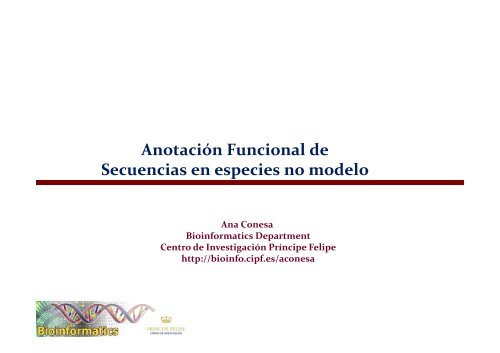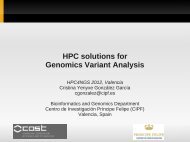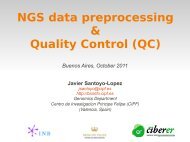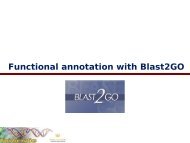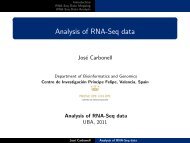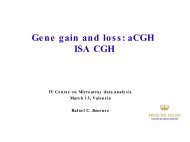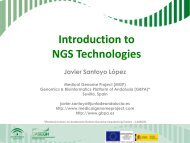Anotación funcional - Bioinformatics and Genomics Department at ...
Anotación funcional - Bioinformatics and Genomics Department at ...
Anotación funcional - Bioinformatics and Genomics Department at ...
You also want an ePaper? Increase the reach of your titles
YUMPU automatically turns print PDFs into web optimized ePapers that Google loves.
<strong>Anotación</strong> Funcional de<br />
Secuencias en especies p no modelo<br />
Ana Conesa<br />
<strong>Bioinform<strong>at</strong>ics</strong> <strong>Department</strong><br />
Centro de Investigación Príncipe Felipe<br />
htt http://bioinfo.cipf.es/aconesa<br />
//bi i f i f /
Créditos<br />
Blast2GO Development:<br />
<strong>Bioinform<strong>at</strong>ics</strong> <strong>Department</strong><br />
Centro de Genómica<br />
CIPF, Valencia<br />
IVIA, Valencia<br />
Ana Conesa<br />
Javier Terol<br />
Stefan Goetz Manuel Talón<br />
Blast2GO special thanks to:<br />
ANNEX :Simen Myhre, Henrik Tveit (MTNU)<br />
GOSSIP: Nils Blüthgen (MicroDiscovery GmbH)<br />
ZVTM: Emmanuel Pietriga (INRIA)<br />
goslim goslim.tair.obo: tair obo: Suparna Mundodi (TAIR)<br />
Biomedical Inform<strong>at</strong>ics<br />
UPV, Valencia<br />
Juan Miguel Gómez<br />
Montserr<strong>at</strong> Robles<br />
Curso Bioinformática, 19 Diciembre 2007, Universida de Alicante
Contenido<br />
1. Conceptos p y<br />
necesidad de anotación<br />
2. <strong>Anotación</strong> <strong>funcional</strong> mediante B2G<br />
• Estr<strong>at</strong>egia<br />
• Aplicación informática<br />
33. Uso del B2G por la comunidad<br />
científica<br />
44. Ejercicio práctico<br />
Curso Bioinformática, 19 Diciembre 2007, Universida de Alicante
<strong>Anotación</strong> <strong>funcional</strong>, ¿por qué?<br />
Secuenciación a gran escala “for everybody”<br />
Proyectos de genoma proteoma<br />
Proyectos de ESTs<br />
A N O T A C I ON D E S E C U E N C I A S<br />
transcriptoma<br />
Curso Bioinformática, 19 Diciembre 2007, Universida de Alicante
Aclaraciones sobre “anotación”<br />
Función de proteína: se refiere<br />
al funcionamiento<br />
molecular de la proteina<br />
e.g. tyrosine kinase<br />
<strong>Anotación</strong> <strong>funcional</strong>: sentido<br />
más amplio amplio, caracterización<br />
biológica de la proteína<br />
e.g. g stress‐rel<strong>at</strong>ed protein p<br />
Sí<br />
¿Función localizable<br />
en la molécula?<br />
No<br />
necesariamente<br />
Curso Bioinformática, 19 Diciembre 2007, Universida de Alicante
<strong>Anotación</strong>: una posible ontología<br />
Referencia<br />
bibliográfica<br />
Interacción<br />
Expresión<br />
<strong>Anotación</strong><br />
Empírica Transferencia<br />
Ensayo<br />
bioquímico<br />
Análisis de<br />
de secuencia<br />
Comparación de<br />
estructura<br />
Homología de<br />
sequencia Identificación<br />
motivos<br />
Filogenia<br />
Identificación<br />
de pliegues<br />
Curso Bioinformática, 19 Diciembre 2007, Universida de Alicante
Sistemas terminológicos<br />
Motivos Funcionales<br />
Función Molecular<br />
Proceso Biológico<br />
Componente Celular<br />
Mapas Metabólicos<br />
KEGG ortólogos<br />
Curso Bioinformática, 19 Diciembre 2007, Universida de Alicante
<strong>Anotación</strong> automática: trampas y dificultades<br />
1. Fuentes de anotaciones erróneas (falta, sobra, incorrecto)<br />
‐> <strong>Anotación</strong> automática como “ “propuesta” ”<br />
2. Transferencia excesiva de funciones: transferencia de<br />
anotaciones en “cis” cis (proteínas “multi‐domain”) multi domain ) y “trans” trans<br />
(procesos biológicos)<br />
‐> Diferente impacto ORFs/Contigs, métodos homología/estructura<br />
3. ¿Genes G parálogos ál comparten t ffunción? ió ?<br />
‐> Contexto celular<br />
44. Especificidad y sensibilidad de métodos (top‐blast) (top blast) bajas<br />
‐> Los dos extremos de la balanza<br />
5. Umbral de alineamiento rel<strong>at</strong>ivo (BBDD, Secuencias,<br />
métodos) é d )<br />
Curso Bioinformática, 19 Diciembre 2007, Universida de Alicante
Servidores y Software<br />
PFP<br />
Protein Analyst y<br />
GOPEP<br />
ProKnow<br />
PFPS<br />
ProFunc<br />
ProtFun<br />
PropSearch<br />
RIO<br />
FIGENIX<br />
GGoBlet Bl t<br />
Gotcha<br />
OntoBlast<br />
Basado en Homología<br />
Usa técnicas de ML<br />
Alta recuperación<br />
Poca interacción<br />
No-intensivo<br />
AAnaliza li estructuras t t 3D Recupera Funciones<br />
Predicción desde estructura No-intensivo<br />
Predicción desde motivos<br />
Recupera Funciones<br />
No-intensivo<br />
Predicción desde filogenia Secuencias protéicas<br />
No-intensvo<br />
Basado en Homología<br />
Asigna GOs del BlastHit<br />
Recupera anotaciones<br />
Curso Bioinformática, 19 Diciembre 2007, Universida de Alicante
Nuestra propuesta<br />
�<strong>Anotación</strong> �<strong>Anotación</strong> de secuencias noveles<br />
� Herramienta de d<strong>at</strong>a mining en genómica <strong>funcional</strong><br />
�� Si Sistema IIntensivo i<br />
�Orientado a labor<strong>at</strong>orios biológicos: fácil, visual, intuitivo<br />
Curso Bioinformática, 19 Diciembre 2007, Universida de Alicante
Conceptos de anotación <strong>funcional</strong> en B2G<br />
� Blast<br />
o High‐throuput High throuput Blast<br />
o Tr<strong>at</strong>ar todos los hit vs. top‐blast<br />
o Usar BBDD gr<strong>and</strong>es (NR)<br />
�� Mapeo<br />
o Recuperar lo más posible<br />
o No importa la calidad<br />
� <strong>Anotación</strong><br />
o (Semi)automática (human supervised)<br />
o Combinación de conceptos p<br />
o Filtrado de d<strong>at</strong>os (ajustable, recall vs. precisión)<br />
� Visualización<br />
o Comprobar y validar anotación de manera rápida y sencilla<br />
� Análisis<br />
o Enriquecimiento, Charts, GO‐Slim, “Combined Graphs”<br />
Curso Bioinformática, 19 Diciembre 2007, Universida de Alicante
<strong>Anotación</strong> Funcional con Gene Ontology<br />
� La Gene Ontology (GO) es un<br />
vocabuario controlado para anotar<br />
<strong>funcional</strong>mente genes por su<br />
proceso biologico, funcion<br />
molecular y localización<br />
� El GO es un Direct Acyclic Graph<br />
� Genes están normalmente<br />
anotados td al l nivel i l más á específico ífi<br />
dentro del conocimiento actual.<br />
� La “true p<strong>at</strong>h p rule” asegura g que q<br />
para un gen todos los terminos<br />
desde su anotacion a la raiz son<br />
ciertos<br />
más general<br />
más á especifico<br />
ifi<br />
Curso Bioinformática, 19 Diciembre 2007, Universida de Alicante
<strong>Anotación</strong> en Blast2GO<br />
� Términos de Gene Ontology gy (GO). ( )<br />
� Enzimas (Kegg)<br />
� Motivos (InterPro)<br />
Curso Bioinformática, 19 Diciembre 2007, Universida de Alicante
Conceptos p de anotación <strong>funcional</strong> del B2G<br />
Similitud<br />
EEspecificidad ifi id d Precisión<br />
CCalidad lid d<br />
Selección<br />
Regla de anotación<br />
Curso Bioinformática, 19 Diciembre 2007, Universida de Alicante
Conceptos de anotación <strong>funcional</strong> del B2G<br />
término más bajo<br />
cumpliendo los requisitos<br />
requerimiento de similitud<br />
sim<br />
=<br />
∑ positives<br />
hsp<br />
∑ hsp<br />
calidad de la<br />
anotación t ió “source” “ ”<br />
EC weight<br />
IC 1<br />
TAS 1<br />
IDA 1<br />
IMP 0.9<br />
IGI 0.9<br />
IPI 0.9<br />
ISS 08 0.8<br />
IEP 0.8<br />
NAS 0.7<br />
IEA 0.7<br />
cóódigos<br />
de eevidenciaa<br />
posibilidad de abstracción<br />
Recall<br />
alignmentl ength engthhsp<br />
ND 05 0.5<br />
vs vs.<br />
NR 0.5<br />
RCA 0.5<br />
Precision<br />
lowest. node[(max. sim× ECw) + (# GO× GOw)] ≤threshold<br />
Regla de anotación<br />
Curso Bioinformática, 19 Diciembre 2007, Universida de Alicante
Evaluación<br />
� � … ¿Y Y eso funciona? f i ?<br />
� Método transparente (vs. un/supervised learning)<br />
�� PPrecisión i ió d de anotación t ió con parámetros á t por ddefecto f t alcanza l 6 65‐70%. %<br />
(que son valores típicos obtenidos por método automáticos de<br />
anotación)<br />
� … y Blast2GO ofrece una pl<strong>at</strong>aforma amigable, amplia y variada<br />
Curso Bioinformática, 19 Diciembre 2007, Universida de Alicante
Evaluación<br />
Curso Bioinformática, 19 Diciembre 2007, Universida de Alicante
Software Blast2GO<br />
� Pl<strong>at</strong>aforma universal para:<br />
1. <strong>Anotación</strong> basado en Gene Ontology<br />
2. Análisis estadístico<br />
3. Vi Visualización li ió (DAG) iinteractiva t ti y coloreada l d<br />
� Ideal para la investigación en especies no‐modelo<br />
�� AAplicación li ió ddesktop k iintuitiva i i e interactiva i i<br />
Secuencias<br />
blast análisis <strong>funcional</strong><br />
mapeo<br />
<strong>Anotación</strong><br />
GO GO,EC, EC<br />
…<br />
generación de grafos<br />
Visualización<br />
Curso Bioinformática, 19 Diciembre 2007, Universida de Alicante
Arquitectura<br />
Curso Bioinformática, 19 Diciembre 2007, Universida de Alicante
Arquitectura<br />
Curso Bioinformática, 19 Diciembre 2007, Universida de Alicante
Buscar de secuencias similares con BLAST<br />
Parámetros:<br />
•URL del Servidor<br />
• BBDD de secuencias<br />
•Blast‐Tipo<br />
(blastx, blastp,...)<br />
•Form<strong>at</strong>o de<br />
Resultados<br />
Mas parámetros:<br />
•E‐Value l Cutoff ff<br />
•Number of Hits<br />
• Mi Minimum i HSP<br />
length<br />
Curso Bioinformática, 19 Diciembre 2007, Universida de Alicante
Buscar secuencias similares con BLAST<br />
Curso Bioinformática, 19 Diciembre 2007, Universida de Alicante
Mapeo de términos GO con secuencias<br />
Fuentes del mapeo:<br />
� Gene Ontology BBDD: contiene mas de ~2<br />
milliones de “productos geneticos” anotado en GO, de<br />
Arabidopsis hasta Zebrafish.<br />
� NCBI Fl<strong>at</strong> Files: gene2accession (4 079 414 entries)<br />
gene_info (1 635 614 entries)<br />
� PIR ‐ Non‐Redundant Reference Protein D<strong>at</strong>abase:<br />
incluye PSD, UniProt, Swiss‐Prot, TrEMBL, RefSeq,<br />
GenPept y PDB<br />
Hit<br />
ACC/GI<br />
Mapping<br />
RResources<br />
EC<br />
GO-Terms GO Terms<br />
sim %<br />
Curso Bioinformática, 19 Diciembre 2007, Universida de Alicante
Mapeo detallado<br />
Blast2GO ast GO sigue sgue3 3 diferentes d e e tes caminos ca os durante du a te el e mapeo apeo para pa a obtener obte e<br />
la máxima información GO posible para los hits:<br />
1. BlastResult Accessions BlastResult.accs are used to retrieve GeneNames (Symbols) y making g<br />
use of two mapping ncbi.gene2accession.protein_accession<br />
files provided by NCBI (gene_info, gene2accession).<br />
Identified GeneNames are ncbi.gene_info.symbol(tax_id)<br />
searched in the species specific entries of the<br />
GeneProduct Table of the GO‐D<strong>at</strong>abase.<br />
go.gene_product.symbol(ncbi_taxa_id)<br />
2. BlastResult GI identifier are used to retrieve UniPort Ids making use of a<br />
BlastResult.gis<br />
mapping file from PIR (Non‐redundant REFerence protein d<strong>at</strong>abase)<br />
pir.nref.uniprot.id<br />
including PSD, UniProt, Swiss‐Prot, TrEMBL, RefSeq, GenPept <strong>and</strong> PDB.<br />
go.dbxref.xref_key<br />
g _ y<br />
Identified Uniprot Ids are searched in the DBXRef Table of the GO GO‐D<strong>at</strong>abase D<strong>at</strong>abase<br />
3. BlastResult Accessions are searched direcly in the DBXRef Table of the GO‐<br />
D<strong>at</strong>abase.<br />
D<strong>at</strong>abase. BlastResult BlastResult.accs accs<br />
go.dbxref.xref_key<br />
Curso Bioinformática, 19 Diciembre 2007, Universida de Alicante
Mapeo de términos GO con secuencias<br />
Curso Bioinformática, 19 Diciembre 2007, Universida de Alicante
<strong>Anotación</strong> GO<br />
Curso Bioinformática, 19 Diciembre 2007, Universida de Alicante
Gráficas Descriptivas <strong>Anotación</strong><br />
Curso Bioinformática, 19 Diciembre 2007, Universida de Alicante
Modulación de la anotación<br />
Cambiar la anotación manualmente<br />
GO‐Term ACC<br />
EC‐Codes<br />
Seq. Description<br />
Extender con el “Second Layer”<br />
Myhre et al, <strong>Bioinform<strong>at</strong>ics</strong> 2006<br />
Resumir con el GOSlim”<br />
is involved in<br />
OBO GO‐Slim File<br />
MMolecular l l FFunction ti<br />
acts in<br />
Biological Process Cellular Component<br />
Curso Bioinformática, 19 Diciembre 2007, Universida de Alicante
<strong>Anotación</strong> de KEGG p<strong>at</strong>hways<br />
GO � Enzyme y Codes � KEGG maps p<br />
Curso Bioinformática, 19 Diciembre 2007, Universida de Alicante
<strong>Anotación</strong> de Motivos de InterPro<br />
Utilizar el servicio web del EBI para buscar en InterProScan y parsear resultados<br />
Curso Bioinformática, 19 Diciembre 2007, Universida de Alicante
Visualización (Una secuencia)<br />
Curso Bioinformática, 19 Diciembre 2007, Universida de Alicante
Visualización (Varias Secuencias)<br />
Curso Bioinformática, 19 Diciembre 2007, Universida de Alicante
Visualización (Varias Secuencias)<br />
Conceptos:<br />
� Herramienta para explorar y descubrir<br />
� Grafos interactivos y “zoomable”<br />
� Grafos coloreados “highlighting hot areas”<br />
Acumulación por nodo<br />
(Sequence Count)<br />
Información entrante<br />
(Node Score)<br />
∑<br />
d<br />
score = # seq× α<br />
1<br />
4<br />
3<br />
1 3<br />
1<br />
2.4<br />
3<br />
1 3<br />
Curso Bioinformática, 19 Diciembre 2007, Universida de Alicante<br />
5<br />
2.5<br />
1<br />
1
Análisis estadístico (Fisher´s Exact Test)<br />
� El algoritmo comprueba para todos los<br />
términos GO si están enriquecidos en un<br />
grupo de prueba comparado con un grupo de<br />
referencia us<strong>and</strong>o “Fisher’s Exact Test” y<br />
“Multiple testing correction”<br />
� Todos los niveles del grafo GO están<br />
considerados y el algoritmo suma para cada<br />
nodo en el DAG cuantos genes en el “test set”<br />
y “ “reference f set” ” están á anotados d di directa o<br />
notación<br />
indirectamente con este término.<br />
An<br />
Servidor B2G<br />
Cliente<br />
Ref.:<br />
Blüthgen,N., Br<strong>and</strong>,K., Cajavec,B., Sw<strong>at</strong>,M., Herzel,H. <strong>and</strong> Beule,D., (2004) Biological Profiling of<br />
Gene Groups utilizing Gene Ontology –A St<strong>at</strong>istical Framework. arXiv:q‐bio.GN/0407034, 1, 1.<br />
Curso Bioinformática, 19 Diciembre 2007, Universida de Alicante<br />
Visuualización
Análisis estadístico (Fisher´s Exact Test)<br />
Curso Bioinformática, 19 Diciembre 2007, Universida de Alicante
Estadísticas a partir de grafos<br />
•Sequence Distribution/GO<br />
as Bar‐Chart<br />
•Sequence Distribution/GO<br />
as Level‐Pie (level ( selection) )<br />
•Sequence Distribution/GO as Multilevel‐Pie (#score or #seq cutoff)<br />
Curso Bioinformática, 19 Diciembre 2007, Universida de Alicante
Blast2GO4Pipe<br />
Resultados Blast en<br />
form<strong>at</strong>o XML<br />
Pipe Versión:<br />
B2G sin interfaz f grafico f<br />
para Win/Linux/Mac<br />
Integración de la anotación automática de GOs<br />
dentro de un “Pipeline” u otro aplicación<br />
http://www.blast2go.de/b2gd<strong>at</strong>a/b2g4pipe.tar.gz<br />
configuración con un fichero<br />
de propiedades<br />
Anotaciones en un<br />
fichero .annot<br />
Curso Bioinformática, 19 Diciembre 2007, Universida de Alicante
Elementos adicionales<br />
•Blast Import(xml)/Export(html/txt/xml)<br />
p ( ) p ( )<br />
• Annot<strong>at</strong>ion import by ACC or Symbols<br />
•B2G Tutorial<br />
•Local Install<strong>at</strong>ion (B2G DB setup How‐To)<br />
•B2G B<strong>at</strong>ch‐Mode<br />
•<strong>Anotación</strong> de Enzimas KEGG<br />
• Ejecución de InterProScan<br />
….. y en un futuro cercano:<br />
•Blasten Grid publico<br />
• Blast2GO en la web (Babelomics)<br />
•Fisher contra genoma entero<br />
•B2G como parte de BioMoby Web Service<br />
Curso Bioinformática, 19 Diciembre 2007, Universida de Alicante
Uso mundial del Blast2GO<br />
Especies<br />
Citrus Citrus, nicotiana nicotiana, maize maize, soybean soybean, tom<strong>at</strong>o, tom<strong>at</strong>o grape… grape<br />
Streptococcus, Trichoderma, Schistosoma, Cyanobacteria…<br />
European Flounder,pig, flidder crab, r<strong>at</strong>, honneybee, human…<br />
Metagenome projects…<br />
Curso Bioinformática, 19 Diciembre 2007, Universida de Alicante
Estadísticas del Uso<br />
800<br />
700<br />
600<br />
500<br />
400<br />
300<br />
200<br />
100<br />
0<br />
Monthly Avg. Visits:<br />
Total different visitors (ip) since June 2005: 6028<br />
Jul. 2005<br />
Sep. 2005<br />
Nov. 2005<br />
Jan. 2006<br />
March 2006<br />
May 2006<br />
Jul 06<br />
Sep 06<br />
30<br />
25<br />
20<br />
15<br />
10<br />
5<br />
0<br />
Jul. 20055<br />
Daily Avg. Vis its:<br />
Sept. 2006 - 25 Visitors (avg) a day<br />
Sep. 20055<br />
Nov. 20055<br />
Jan. 20066<br />
March 20066<br />
May 20066<br />
Curso Bioinformática, 19 Diciembre 2007, Universida de Alicante<br />
Jul 066<br />
Sep 066
Presesencia<br />
WWeb: b<br />
http://www.geneontology.org<br />
http://www.blast2go.de<br />
http://groups.google.com/group/Blast2GO<br />
Paper: p<br />
Ana Conesa, Stefan Götz, Juan Miguel García‐Gómez, Javier Terol, Manuel<br />
Talón <strong>and</strong> Montserr<strong>at</strong> Robles<br />
Blast2GO: A universal tool for annot<strong>at</strong>ion, visualiz<strong>at</strong>ion <strong>and</strong> analysis in<br />
functional genomics research.<br />
<strong>Bioinform<strong>at</strong>ics</strong> 2005 21: 3674‐3676<br />
Curso Bioinformática, 19 Diciembre 2007, Universida de Alicante
Ejemplos de usos en “papers” (I)<br />
Ref.:<br />
<strong>Anotación</strong> de ~16.000 Unigenes<br />
‐ Parámetros por defecto<br />
‐ Resultado general:<br />
‐1 a 4 anotaciones/Unigen<br />
‐Anotaciones en las 3 c<strong>at</strong>egorías g<br />
‐Fallos = sin homólogos<br />
Curso Bioinformática, 19 Diciembre 2007, Universida de Alicante
Ejemplos de uso en “papers” (II)<br />
Ref.:<br />
<strong>Anotación</strong> de ~21 ~21.000 000 “chip chip fe<strong>at</strong>ures fe<strong>at</strong>ures”<br />
‐ Uso como herramienta de anotación<br />
‐ Uso como “d<strong>at</strong>a d<strong>at</strong>a mining tool tool”<br />
Curso Bioinformática, 19 Diciembre 2007, Universida de Alicante
Ejemplos de uso en “papers” (III)<br />
Ref.:<br />
Generación de un chip de pl<strong>at</strong>ija<br />
‐ Estudio de cambios en<br />
transriptoma como marcador de<br />
contaminación.<br />
‐ B2G como herramienta de<br />
anotación y análisis <strong>funcional</strong><br />
‐ Identificación de c<strong>at</strong>egorías<br />
<strong>funcional</strong>es sobrerexpresentadas<br />
relacionadas con stress<br />
Curso Bioinformática, 19 Diciembre 2007, Universida de Alicante
Software Demo (I)<br />
Objetivo<br />
Conocer el Blast2GO como herramienta de anotación y análisis <strong>funcional</strong>.<br />
Recursos:<br />
Software via Java Web Start: http://www.blast2go.de/<br />
DD<strong>at</strong>os: t http://www.blast2go.de/b2gd<strong>at</strong>a/murcia.zip<br />
htt // bl t2 d /b2 d t / i i<br />
Desarrollo (I):<br />
• Durante este ejercicio se va a ver cómo asignar semi-automáticamente semi automáticamente funciones biológicas<br />
definido por la "Gene Ontology" a secuencias de ADN no conocidas en base a búsquedas<br />
BLAST.<br />
• Desde la página web del B2G se puede ejecutar la aplicación vía Java Web Start. Se abre el<br />
fichero (10Seqs (10Seqs.fasta) fasta) adjunto con la aplicación B2G B2G.<br />
• Blast: Búsquedas de similitudes con el NCBI Qblast (parámetros estándar) y se generan las<br />
estadísticas correspondientes con el menú “St<strong>at</strong>istics“. Revisa los resultados Blast de algunas<br />
secuencias "blasteadas“ us<strong>and</strong>o el botón derecho sobre la secuencia correspondiente en la<br />
ttabla bl dde secuencias. i GGuardar d y visualizar i li el l fi fichero h .xml l<br />
• Mapping: Menu -> Mapping -> Start Mapping -<br />
correspondientes con el menú “St<strong>at</strong>istics".<br />
y se generan las estadísticas<br />
• Anot<strong>at</strong>ion: Menu -> Annot<strong>at</strong>ion -> Start Annot<strong>at</strong>ion - y se generan g las estadísticas<br />
correspondientes con el menú “St<strong>at</strong>istics".<br />
Curso Bioinformática, 19 Diciembre 2007, Universida de Alicante
Software Demo (II)<br />
Desarrollo (II):<br />
• Ampliar las anotaciones us<strong>and</strong>o la herramienta “Annex” Annex en el menú “Annot<strong>at</strong>ion” Annot<strong>at</strong>ion y observa los<br />
resultados en “Applic<strong>at</strong>ion Messages”.<br />
• Complementar/cambiar la anotación de la secuencia no.3 manualmente us<strong>and</strong>o enlaces al<br />
NCBI y Amigo, "The Gene Ontology Web Browser" (www.geneontology.org)<br />
• PPara conseguir i eso se abre b el l menú ú ddel l contexto t t dde esa secuencia i (b (botón tó dderecho) h ) y se abre b<br />
los resultados blast, las descripciones GO y el grafo de la anotación de las 3 c<strong>at</strong>egorías de<br />
esta secuencia.<br />
• Busca en el Amigo los términos biológicos más frecuentes del resultado blast (ubiquitin) y<br />
compara los resultados con las anotaciones hechas por el B2G. Con el menú ítem: "Change<br />
annot<strong>at</strong>ion <strong>and</strong> description" añade esa nueva anotación encontrado en el Amigo (protein<br />
ubiquitin<strong>at</strong>ion).<br />
• Vuelve a generar g el ggrafo de esa anotación ppara<br />
ver el cambio.<br />
• Visualización: Visualizar la anotación de esta secuencia y generar un "Combined Graph" del<br />
conjunto de secuencias/anotaciones del grafo "molecular function". Repetir cambi<strong>and</strong>o Node<br />
Score Filter a 1.<br />
• Fisher Fisher. Hacer un análisis de enriquecimiento y visualizar d<strong>at</strong>os d<strong>at</strong>os. Utilizar ficheros<br />
reference.annot y test.txt.<br />
Curso Bioinformática, 19 Diciembre 2007, Universida de Alicante
Para terminar<br />
� … os invitamos a probarlo en www.blast2go.de<br />
�� Y nos alegramos siempre de recibir “feedback” feedback<br />
� ¿Más preguntas?<br />
Curso Bioinformática, 19 Diciembre 2007, Universida de Alicante


